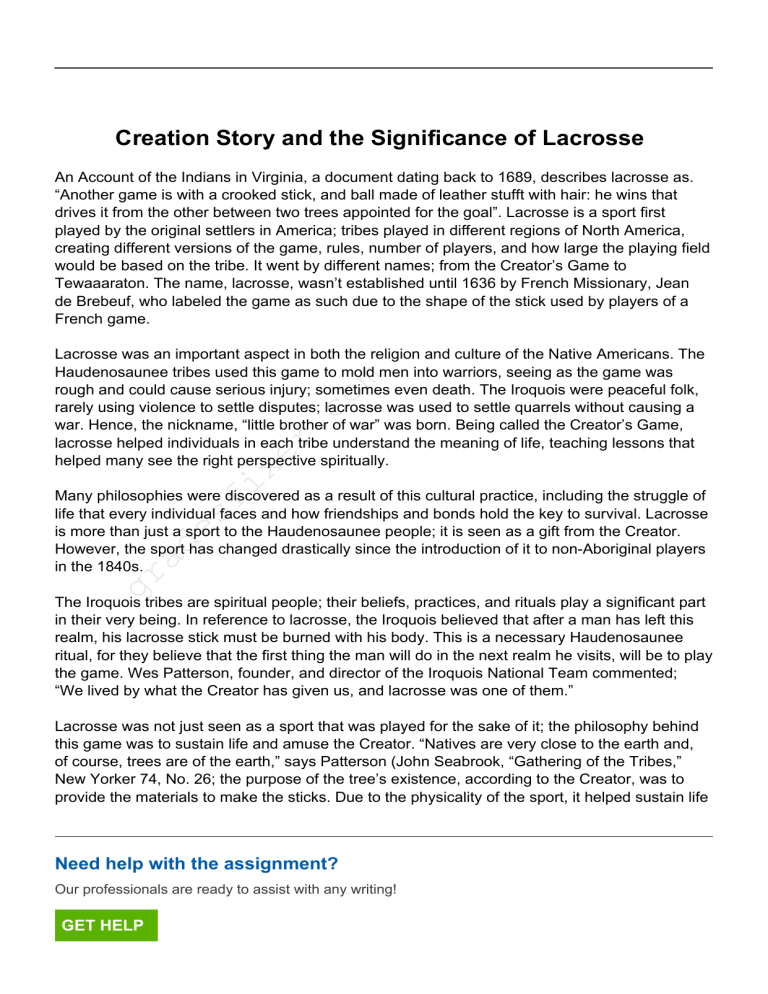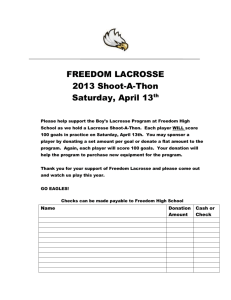
Creation Story and the Significance of Lacrosse An Account of the Indians in Virginia, a document dating back to 1689, describes lacrosse as. “Another game is with a crooked stick, and ball made of leather stufft with hair: he wins that drives it from the other between two trees appointed for the goal”. Lacrosse is a sport first played by the original settlers in America; tribes played in different regions of North America, creating different versions of the game, rules, number of players, and how large the playing field would be based on the tribe. It went by different names; from the Creator’s Game to Tewaaaraton. The name, lacrosse, wasn’t established until 1636 by French Missionary, Jean de Brebeuf, who labeled the game as such due to the shape of the stick used by players of a French game. es fi xe r. c om Lacrosse was an important aspect in both the religion and culture of the Native Americans. The Haudenosaunee tribes used this game to mold men into warriors, seeing as the game was rough and could cause serious injury; sometimes even death. The Iroquois were peaceful folk, rarely using violence to settle disputes; lacrosse was used to settle quarrels without causing a war. Hence, the nickname, “little brother of war” was born. Being called the Creator’s Game, lacrosse helped individuals in each tribe understand the meaning of life, teaching lessons that helped many see the right perspective spiritually. gr ad Many philosophies were discovered as a result of this cultural practice, including the struggle of life that every individual faces and how friendships and bonds hold the key to survival. Lacrosse is more than just a sport to the Haudenosaunee people; it is seen as a gift from the Creator. However, the sport has changed drastically since the introduction of it to non-Aboriginal players in the 1840s. The Iroquois tribes are spiritual people; their beliefs, practices, and rituals play a significant part in their very being. In reference to lacrosse, the Iroquois believed that after a man has left this realm, his lacrosse stick must be burned with his body. This is a necessary Haudenosaunee ritual, for they believe that the first thing the man will do in the next realm he visits, will be to play the game. Wes Patterson, founder, and director of the Iroquois National Team commented; “We lived by what the Creator has given us, and lacrosse was one of them.” Lacrosse was not just seen as a sport that was played for the sake of it; the philosophy behind this game was to sustain life and amuse the Creator. “Natives are very close to the earth and, of course, trees are of the earth,” says Patterson (John Seabrook, “Gathering of the Tribes,” New Yorker 74, No. 26; the purpose of the tree’s existence, according to the Creator, was to provide the materials to make the sticks. Due to the physicality of the sport, it helped sustain life Need help with the assignment? Our professionals are ready to assist with any writing! GET HELP amongst the tribe. The concept of lacrosse is beautiful, and one that will never be understood by non-indigenous people. The history of Native Americans, including the Haudenosaunee tribes, continue to go unrecognized. Too often is Native American history overlooked in a country’s educational system or being taught inaccurately. History textbooks do not include a fair, historical perception on Native Americans, nor is their influence on culture today recognized. The same stereotypes are used when discussing the aboriginals of this country; a drunk, half-naked savages scalping, and burning, or a mocking portrayal of shamans. om As with every other aspect of the Native culture, lacrosse held spiritual meaning; it wasn’t just a game being played to pass time, rather it was a teaching tool, a religion, and a means to create a relationship with neighboring tribes. Today, the history behind the meaning has been disenfranchised by the colonizers who sought to take a spiritual practice and submerge it in a cloud of Eurocentric standards. It has now been subjected to being just like any other sport played in friendly competition. es fi xe r. c Lacrosse was introduced to non-aboriginal individuals during the 1840s. It became a way to ensure national unification by the Canadians during the Confederation, continuing to be influential decades later. White settlers then banned Aboriginals from championship competition by 1880; the game then suffered dramatic alterations during that time. The Canadians tried to use the cultural background of the sport to create the narrative that it was something uniquely Canadian. gr ad During 1983-1990, the Haudenosaunee tribes, barred for more than a century, attempted to reenter international competition as a sovereign nation. These tribes created the Iroquois Nationals lacrosse team that represented the Six Nations. The establishment of this Haudenosaunee Confederacy created a narrative that sought for the Haudenosaunee people to be re-welcome into the game that was stolen from them. The Six Nations continued to be isolated from the international field of lacrosse through the 18th and 19th centuries. It wasn’t until the rise of Native activism in the 20th century did their message get across. The early 1950s and 1960s invoked a change in behavior between Natives and non-Natives throughout Canada and the United States. Ken Coates, a US historian, described the change as follows; “It is not that Aboriginal peoples discovered their voice in the 1950s and beyond. Rather, select groups of non-indigenous peoples and countries discovered how to hear the words and pleas that had so often been spoken.” During this time, the Native people began to unite against federal policies including the White Paper in 1967 and the occupations of Alcatraz Island in 1969. However, the siege of Wounded Need help with the assignment? Our professionals are ready to assist with any writing! GET HELP Knee, resulted in many young Native activists as well as Native vocal leaders who sought to expose the conditions that Native people across North America had been enduring the last several years. Increasing political influence regarding the mobilization of Aboriginal communities, including the Six Nations, helped establish a, “nation-to-nation relationship” with the United States and Canada. Oren Lyons, an influential Native leader, began working at the University of Buffalo. While teaching in the Department of American Studies in the 1970s, he met a Haudenosaunee individual, Rick Hill. Lyons, Hill, and Patterson later cultivated a program that would revitalize the cultural impact of lacrosse on an international scale. Lyons, throughout his educational career, described lacrosse as a ceremonial tradition that, “had been gifted to the people by the Creator and retained the potential power to heal or to resolve conflict.” xe r. c om Today, the spiritual game of lacrosse is played across high school and college campuses across the United States. It serves as a dual national sport with Canada, being just as popular as ice hockey. The sport still holds its Native American lineage; it cultivates social relationships while also being a reliever of stress and conditioning on the body. Lacrosse has never lost its cultural and spiritual value within Native tribes; it is still seen as a means of worship played to appease the Creator. gr ad es fi Many tribes have their own mythology regarding the Creation Story and the significance of lacrosse; however, they all agree that the activity itself brings good weather for their crops and helps to heal their sick. Lacrosse has and always will hold merit within the Haudenosaunee tribe as well as all Native society; it is prevalent in all aspects of the Aboriginal lifestyle. Need help with the assignment? Our professionals are ready to assist with any writing! GET HELP Powered by TCPDF (www.tcpdf.org)




